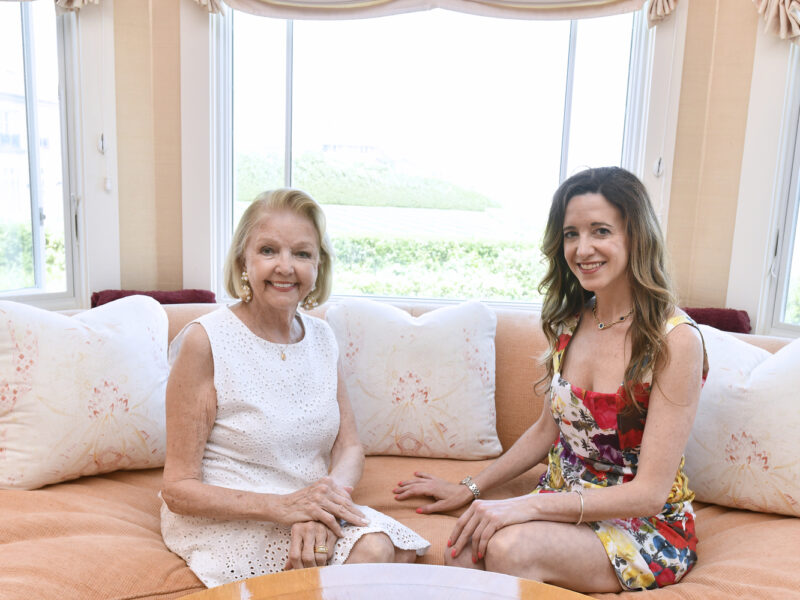

Tristan Dyer: Talk to me about the history of your East Hampton home and what drew you to this property originally.
Darlene Liebman: My father, Dr. Irving Liebman, discovered this property was for sale in 1983. The beauty of Lily Pond Lane drew him in immediately. The incredible sycamore trees that frame the lane, the manicured hedges, stately homes and of course the ocean view was spectacular. The house was named Mostly Dune and still holds that name today.
My father purchased the home from the Manhattan School of Music, who had been using it as a summer residence for their students. The upkeep of the home had become overwhelming for the school.
The home was built in 1916 by a local architect and developer, Mary B. Talmage, and even then was built for the main purpose of renting out to summer residents.
The house eventually came into the possession of Mrs. Dorothy Quick, a writer of numerous science fiction books (she helped start the genre) and a popular column of The East Hampton Star who treasured a childhood friendship with Mark Twain.
TD: Was there a designer and architect involved in the renovation process, and have you additionally reimagined the space to your own taste?
DL: The house was decorated by Tim Macdonald and the architect was Eugene Futterman. The house was renovated and kept in the Classic Hamptons, a large seaside cottage. Shingles, large airy rooms, large windows with muted soft neutrals colors and an elegant style. The house is surrounded by windswept dunes, tall sea grass, hydrangeas in bloom, and sandy beaches.
TD: Color plays such a vital role in shaping the atmosphere. What inspired your choices in paint, wallpapers, or finishes, and how do they reflect the comforting life in the Hamptons?
DL: This house is all about simple elegance. It was first and foremost a family home. A sense of luxury and tranquility, with a focus on natural light, airy spaces, and a connection to the sea.
TD: With the kitchen not just being utilitarian but a centerpiece for gathering, how have you designed this space to balance beauty with function?
DL: My parents loved to entertain, and the layout of the kitchen reflects that. There is a huge island in the middle of the kitchen and enough seats for everyone to enjoy breakfast together. Just like most families, we live in the kitchen. My mother, Mrs. Doris Liebman, is an avid cook, and her favorite cookbook is still from Loaves & Fishes.
TD: Would you describe this East Hampton home as a place to entertain and host, or is it more of a quiet refuge? And how do you balance those dynamic differences?
DL: The house was built to entertain. And the Liebman family loves to throw a party. On most summer weekends you will find us gathered in front of the pool hosting lunches for 15-plus friends.
During the week the house is very peaceful. The crash of the waves and songs of the birds are our permanent audio backdrop. The sunrises and sunsets are always spectacular. There is nothing better than waking up at dawn and watching the sun rise and the surfers catch their waves down at the jetty.
TD: What do you cherish most about living in your home?
DL: Mostly Dune is first and foremost a home, somewhere people feel comfortable being and hanging out. Everyone loves coming over to experience the house and each other.
Our favorite room in the house is the sun room. Its view of the sea and the sunset makes it the most relaxing and spectacular place in the house. Mostly Dune is all about the sea. The planks on the living room floor even come from an old ship.
TD: Are there pieces in your home such as art, objects, or furniture that carry a story or legacy? Can you share a few favorites and how they anchor the space emotionally or visually?
DL: For Dorothy Quick’s birthday on September 1, [Samuel] Clemens sent a telegram offering to send her elephants and monkeys. When Dorothy replied she would rather have his books, he sent them and later gave her a tiny white elephant. It was a gift that would lead to her lifelong interest in collecting elephant statuettes, which would number over 1,000 by the time she died.
We still have and showcase many of Dorothy’s old trinkets, dishes, books and knickknacks. Our favorite is the elephant weathervane (from the original house) that now sits upon the guest house.
A carved marble bench that is from the original house is something I love and treasure.
My mother recently purchased an Alex Katz print called “The Coca Cola Girl.” It’s very modern and bold. It’s a wonderful dichotomy to the more historic feel of the home.
TD: When envisioning a well-rounded room, what do you feel are the final touches that truly complete a space?
DL: Family photographs and personal mementos. They bring warmth and familiarity to any room.
TD: What brought you to the Hamptons, and how do you utilize the town’s amenities and offerings?
DL: Town has changed a lot over the years. When we arrived it was illegal to have any name brand shops in East Hampton. Luckily our favorite spots are still around, the East Hampton Library being one. It’s a great place to research the history of the Hamptons and is a wonderful place to discover new books and read the paper.
The duck ponds where we always take our guests. We get lost in the back pathways talking to the ducks and bring our old stale bread for them.
The Palm is somewhere we’ve always celebrated everyone’s birthday. We have such incredible memories of sitting on the porch with the waiters singing to us.
 More Posts from Tristan Dyer
More Posts from Tristan Dyer